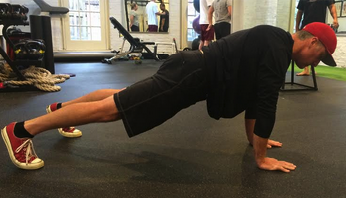Many individuals have a very difficult time keeping their cores in check when they perform push ups. They tend to sag in the hips and overarch their low backs. If I had to guess, I’d say 33% of men and 66% of women exhibit this problem when they perform push ups.
The dead-stop reset push up has you starting from the bottom position. First, you posteriorly tilt the pelvis with a giant glute squeeze and lock down the core. Next, you perform the push up while trying your best to maintain this core positioning throughout the concentric and eccentric portion of the set. Then, you pause at the bottom and reset.
These are much harder than standard push ups for most people but they will teach individuals to control their lumbopelvic hip complexes (LPHC) and keep them static while performing dynamic push ups.

Left: Anterior Pelvic Tilt (APT) – this is undesirable in a push-up. Right: Posterior Pelvic Tilt (PPT) – this is the position you want in a push up (neutral is fine too)
Below is a video of Camille performing 3 reps. Notice that her form still isn’t perfect – you still see some hinging at the mid-back. These are very challenging for her; she can normally perform 10 bodyweight push ups but she typically anteriorly tilts her pelvis and hyperextends her lumbar spine. With the dead-stop reset push-up, she can only perform 3 reps but her form is markedly better. My guess is that in 6 weeks of employing these twice per week, she’ll be doing push ups like a boss while keeping her LPHC solid.
The dead-stop reset push-up serves as an excellent teaching tool for proper push up performance, I hope you give it a try!








Great article, especially for those whom have the ability to perform the concentric action of the push-up. I think a large number of people would find it beneficial for you to expand this for those whom have been unable to perform this portion of the exercise. I have piggy-backed off of those that came before me (Joe DeFranco articles started me on this approach) and find that the exercise starting in the top position and focusing on controlled full range of motion until form breakdown (if possible), then progressing to controlled eccentric on toes/concentric on knees has a high percentage of success over both sexes (approximately 80 individuals) versus previous methods I have attempted (same stats) ….meaning I would love to see this information reprocessed with a focus on muscular activity and/or proper scientific backing.
Also in regards to this article, it reminds me of Stuart McGill’s approach to pull-ups which I personally have found to be an excellent framework.
Timely topic.
Mike Robertson also has an Exciting new push up technique!
You exhale all of your air and do the rep part without oxygen. This keeps the ribcage down!
The progression might involve blowing into a balloon., dunno.
I am not yet strong enough to do full pressups. Is it a good idea to do half pressups from the knees, or with hands on a bench (which I find harder)? Or alternatively just do other exercises in the hope of developing enough strength eventually? Thanks for all your thought-provoking articles.
As a trainer, I have found great improvement with my clients who have problems with performing proper pushups without excessive anterior pelvic tilt, the pelvic tilt still occurs but the reset eliminates the gross exaggeration of the tilt. More practice will equal better form. Thanks again for your research and advice!